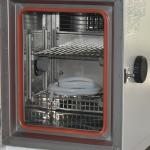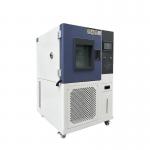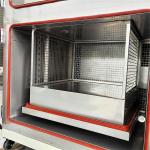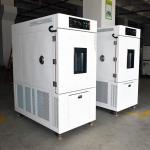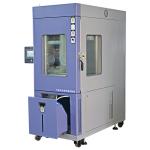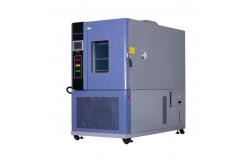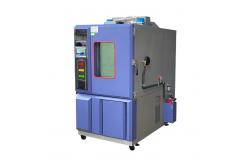In the highly advanced and competitive realm of semiconductor
manufacturing, the 150L Temperature Humidity Test Chambers have
emerged as a crucial asset for ensuring the reliability and
performance of semiconductor components. These chambers are
designed to subject semiconductor chips and related materials to a
precisely controlled range of temperature and humidity conditions,
mimicking the diverse and often harsh environments they may
encounter during their lifecycle. The 150L Temperature Humidity Test Chambers are specifically
engineered to evaluate the stability and durability of
semiconductor components. With a capacity of 150 liters, they
provide an ideal testing space for a significant number of samples,
allowing for comprehensive and efficient testing procedures. In the
semiconductor industry, where even the slightest defect or
instability can lead to catastrophic failures in electronic
devices, these chambers play a vital role in quality control,
research and development, and product validation. By subjecting
semiconductor components to extreme temperature and humidity
levels, manufacturers can identify potential weaknesses, optimize
manufacturing processes, and enhance the overall quality and
reliability of their products. - Robust and Controlled Chamber Design
- The chamber is constructed with high-quality, corrosion-resistant
materials to ensure long-term durability and stability. The
interior is designed with a smooth, non-reactive surface to prevent
any contamination or interaction with the semiconductor samples.
The insulation used in the chamber walls is top-notch, providing
excellent thermal and moisture resistance. This insulation helps in
maintaining precise temperature and humidity control, minimizing
any external influences that could affect the test results.
- The door of the chamber is engineered with a reliable sealing
mechanism to create an airtight enclosure. It is equipped with a
heavy-duty hinge and a secure locking system, allowing for easy
access while maintaining the integrity of the internal environment.
The door also features a large viewing window, usually made of
tempered glass, which enables operators to monitor the samples
without disturbing the test conditions.
- Precision Temperature and Humidity Control Systems
- The temperature control system is highly advanced and accurate. It
can maintain a wide temperature range, typically from -40°C to
+150°C, with an accuracy of ±0.3°C. The system utilizes a
combination of heating and refrigeration elements, along with a
sophisticated feedback loop and temperature sensors strategically
placed throughout the chamber. This ensures uniform temperature
distribution and rapid temperature change capabilities, allowing
for efficient thermal cycling experiments.
- The humidity control system is equally precise. It can adjust the
relative humidity from 10% to 95% RH, with an accuracy of ±2% RH.
The chamber is equipped with a high-efficiency humidifier and
dehumidifier, which work in tandem to achieve rapid and accurate
humidity adjustments. The system also features a dew point control
function, which is crucial for testing applications where
condensation needs to be precisely managed.
- Advanced Instrumentation and Data Acquisition
- The chamber is outfitted with a suite of high-quality sensors.
Temperature sensors are distributed evenly within the chamber to
monitor any temperature gradients and ensure a homogeneous thermal
environment. Humidity sensors provide real-time data on the
relative humidity levels. These sensors are connected to a
state-of-the-art data acquisition system that records and stores
all the measured parameters. The data can be accessed and analyzed
in real-time or retrieved later for in-depth studies.
- The control panel of the chamber is user-friendly and intuitive. It
allows operators to easily set the desired temperature and humidity
levels, as well as program complex test sequences. The panel
displays all the relevant information, including current
temperature, humidity, and the status of the control systems. It
also has built-in alarms and safety features to alert operators in
case of any abnormal conditions or system failures.
- Volume and Dimensions: With a capacity of 150L, the chamber offers a spacious yet
controlled testing environment. The interior dimensions are
carefully designed to optimize the distribution of temperature and
humidity, ensuring that all samples are exposed to the same
environmental conditions. The external dimensions are also compact
enough to fit into most laboratory or manufacturing facility setups
without occupying excessive space.
- Temperature Range: As mentioned, the chamber can operate from -40°C to +150°C. This
wide range is essential for testing semiconductor components, as
they may experience significant temperature variations during
operation, from the cold start-up of a device to the heat generated
during continuous use. For example, testing a microprocessor at
both low and high temperatures helps identify any potential thermal
throttling or performance degradation issues.
- Humidity Range: The relative humidity can be adjusted from 10% to 95% RH. In some
applications, such as in the automotive or industrial sectors where
semiconductor components may be exposed to humid environments,
specific humidity levels need to be tested. High humidity can cause
corrosion or other moisture-related issues in semiconductor
materials, and this range allows for comprehensive evaluation.
- Uniformity and Stability: The temperature uniformity within the chamber is maintained
within ±0.5°C, ensuring that all samples experience a consistent
thermal environment. The humidity uniformity is within ±3% RH. The
stability of both temperature and humidity is excellent, with
minimal fluctuations over time, allowing for accurate and
repeatable testing.
- Accurate Simulation of Semiconductor Operating Environments
- The primary function of the 150L Temperature Humidity Test Chambers
is to accurately simulate the various temperature and humidity
conditions that semiconductor components may face. By precisely
controlling these parameters, it allows manufacturers to predict
how their products will perform in real-world applications. For
example, testing a memory chip under different temperature and
humidity conditions can help determine its data retention
capabilities and susceptibility to errors.
- The ability to conduct combined temperature, humidity, and other
environmental stressors (such as voltage or electromagnetic
interference) testing is also a valuable function. In a complex
electronic device, semiconductor components are often exposed to
multiple stressors simultaneously. These chambers can evaluate the
combined effect of these factors on the components, providing a
more comprehensive understanding of their performance and
reliability.
- Enhanced Semiconductor Component Quality and Reliability
- Through rigorous testing in the chamber, semiconductor
manufacturers can identify potential weaknesses in their components
and make improvements. For example, if a particular chip shows
signs of degradation under high humidity and temperature, the
company can explore alternative packaging materials or
manufacturing processes to enhance its resistance. This leads to
the development of more stable and higher-quality semiconductor
products, reducing the risk of failures in the field and increasing
customer satisfaction.
- The test chambers also help in optimizing the storage and
transportation conditions of semiconductor components. By
determining the ideal temperature and humidity settings for these
processes, manufacturers can ensure that the components reach their
destination in the best possible condition, ready for integration
into electronic devices.
- Compliance with Semiconductor Industry Standards and Regulations
- The semiconductor industry is highly regulated, and compliance with
standards such as JEDEC (Joint Electron Device Engineering Council)
is essential. The 150L Temperature Humidity Test Chambers are a
reliable tool for ensuring compliance. Manufacturers can conduct
tests in accordance with these standards, providing evidence of
product stability and reliability. This is crucial for market
access and for building trust with customers and partners.
- Regulatory bodies rely on accurate test results obtained from such
chambers to enforce safety and quality regulations. It serves as a
dependable means for certifying the suitability of semiconductor
components for use in various electronic applications.
- Stringent Manufacturing Process
- The 150L Temperature Humidity Test Chambers for Semiconductor
Component Testing are manufactured under strict quality control
procedures. Each component, from the insulation panels to the
temperature and humidity control systems, is carefully sourced and
inspected for quality and performance. The assembly process is
carried out by highly trained technicians in a clean and controlled
environment, ensuring the proper alignment and functionality of all
parts.
- The calibration of the temperature and humidity sensors and control
systems is a critical and regular part of the manufacturing
process. It is performed using traceable reference standards to
guarantee the accuracy and reproducibility of the test results.
Rigorous quality audits and inspections are conducted at various
stages of production to maintain the highest level of product
quality.
- Quality Certification and Validation
|
